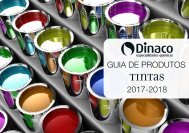Croda's_HLB_Guide
Create successful ePaper yourself
Turn your PDF publications into a flip-book with our unique Google optimized e-Paper software.
Chapter 6<br />
Surfactant Choice Considerations –<br />
General Recommendations<br />
There are several factors to consider when choosing which surfactants will perform best in a system – even beyond<br />
<strong>HLB</strong> value. The following are important to note.<br />
Using a Blend of Surfactants<br />
Let’s assume that you have determined the “Required <strong>HLB</strong>” of your ingredients and it’s 12.0. It might appear that the<br />
proper way to proceed now would be to obtain all the emulsifiers Croda supplies having an <strong>HLB</strong> of 12, or somewhere<br />
around 12, and try them.<br />
However, if you do this, you’re very likely making a serious mistake. First, you’re assuming that having the right <strong>HLB</strong><br />
is enough. However, you must also find the right chemical type having the right <strong>HLB</strong>, as discussed below. Secondly,<br />
you’re missing the opportunity the <strong>HLB</strong> System gives you to tailor-make the ideal surfactant blend for your own set of<br />
ingredients and conditions. By blending two surfactants, you can arrive at the exact <strong>HLB</strong> you need, instead of trying<br />
to “make do” with a single emulsifier having an <strong>HLB</strong> that’s “close but not quite right.” Moreover, you can adjust your<br />
surfactant blend to suit your oil or other active ingredients, instead of having to limit or adjust your active ingredients<br />
to suit the emulsifier.<br />
Bear in mind that the most stable emulsion systems usually consist of blends of two or more emulsifiers, one portion<br />
having lipophilic tendencies, the other hydrophilic. Only in relatively rare instances will you find a single emulsifier<br />
product to suit your requirements, even though it might have the exact <strong>HLB</strong> you need.<br />
Importance of Chemical Type<br />
Knowing the “Required <strong>HLB</strong>” of your ingredients narrows down your choice of emulsifiers considerably, but you’re still<br />
faced with the problem of choosing the ideal chemical type of emulsifiers. At least, when you try different chemical<br />
types, you won’t need to try all sorts of blends of each chemical type – just the one blend having the “Required <strong>HLB</strong>”<br />
you need.<br />
“Right chemical type” is just as important as “right <strong>HLB</strong>.” The two go hand in hand. Suppose you found that a blend<br />
of SPAN 60 and TWEEN 60 (stearates), at an <strong>HLB</strong> of 12, gave you a better emulsion than any other <strong>HLB</strong> of these<br />
two emulsifiers. That <strong>HLB</strong> of about 12 will be best for any chemical type you might try. But now you must determine<br />
whether some other SPAN-TWEEN blend at <strong>HLB</strong> 12 (say laurates, palmitates or oleates) might not be better or more<br />
efficient than the stearates. Or perhaps some chemical family blend outside the popular SPAN-TWEEN class might<br />
be even more suitable. (In any case, remember, it should have an <strong>HLB</strong> of about 12!)<br />
If <strong>HLB</strong> = <strong>HLB</strong> Requirement ➞ GOOD PERFORMANCE<br />
the <strong>HLB</strong> system 15




